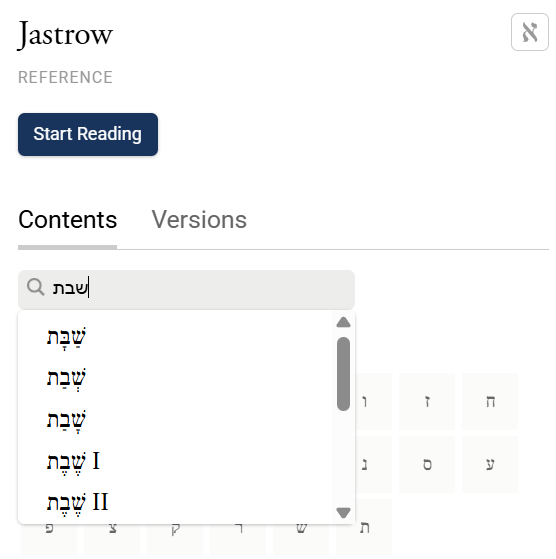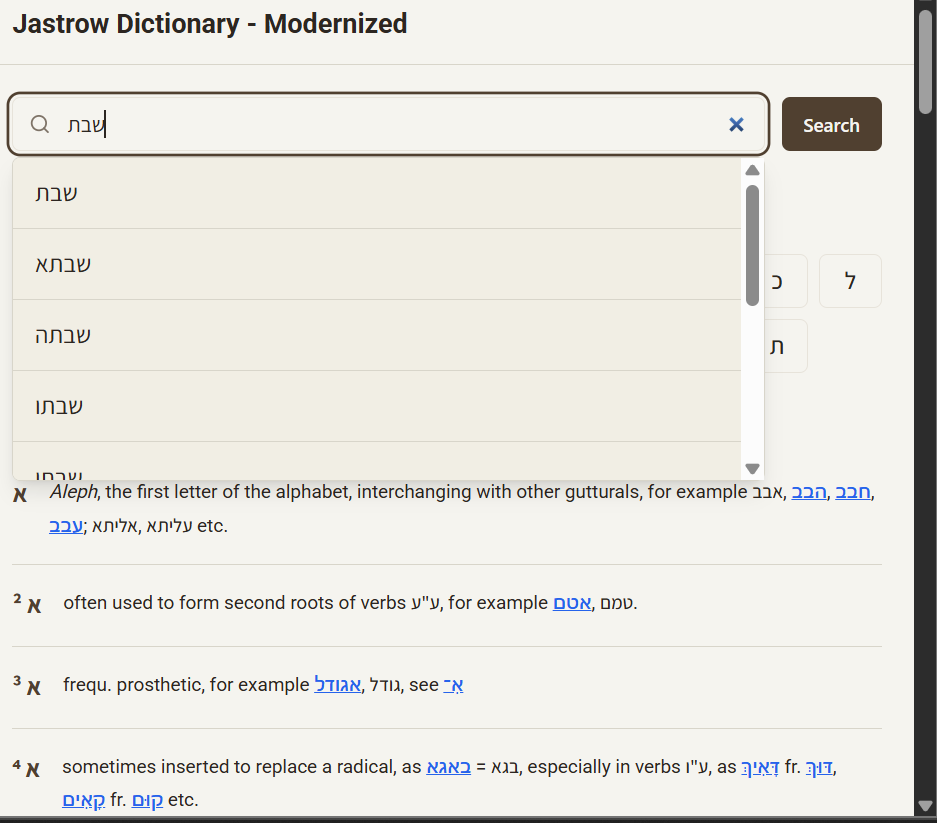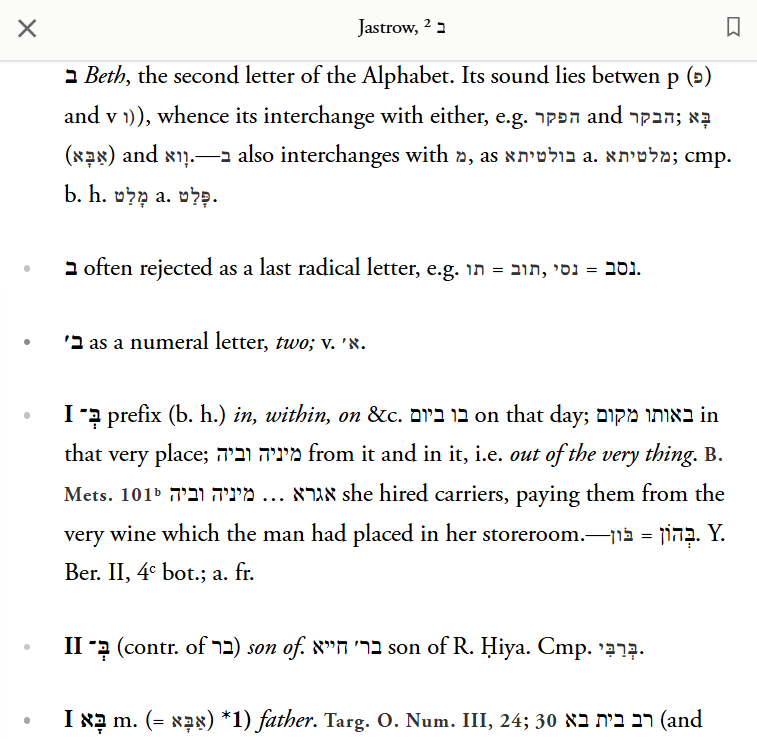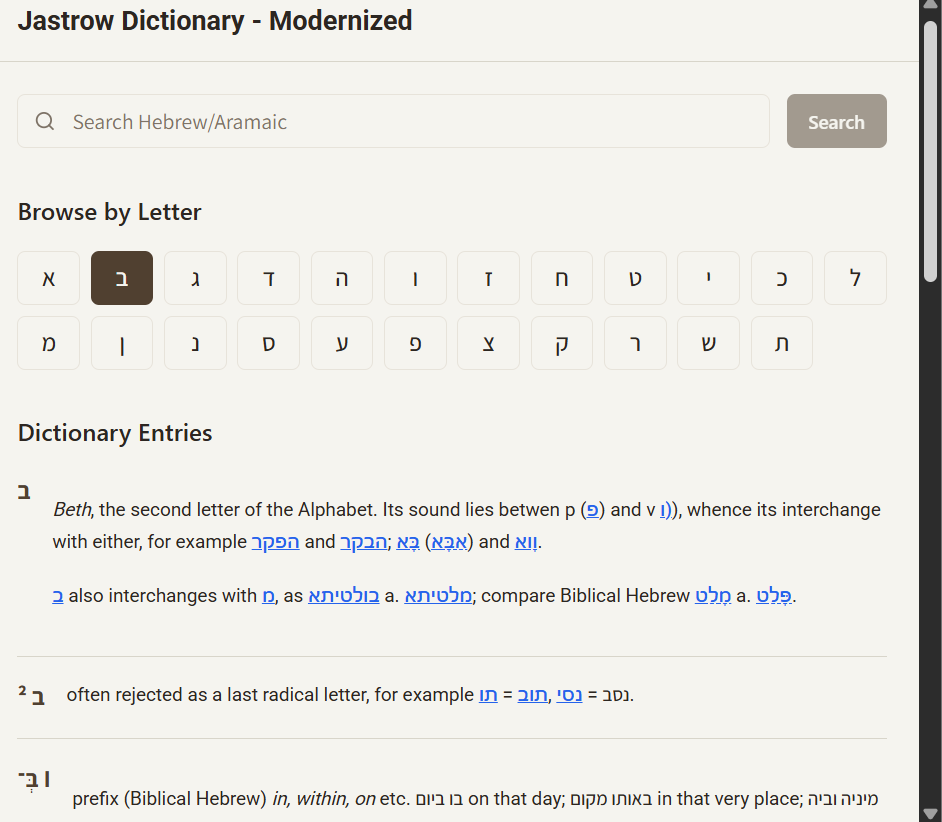Jastrow’s Talmud Dictionary: A Modernized and Enhanced Digital Presentation at ChavrutAI
I built a web application that provides a modernized and enhanced interface for the Jastrow Talmudic lexicon.1 The goal was to make this important resource more accessible and easier to navigate than the existing Sefaria implementation (from which this draws, and is a “wrapper” of). And it's certainly an improvement over the traditional print or PDF versions.
The new page:
https://chavrutai.com/dictionary
Outline
Intro
What It Does
Search
Browsing
Text Processing and Enhancement
Hyperlink Transformation
Paragraph Splitting Example
Enhanced User Experience
Improved Readability Through Structure
Modernized Citations
Expanded Abbreviations
Hyperlinked References
Example - entry ‘אָב II’
Work that needs to be done
Appendix - Technical
What It Does
Like the Sefaria version, the application allows users to search for Hebrew and Aramaic words or browse entries alphabetically by Hebrew letter. When you search for a word, it retrieves the corresponding dictionary entry from the Jastrow lexicon, complete with definitions, grammatical information, and cross-references to biblical and rabbinic sources.
Search
The search and browsing functionality emulates Sefaria’s.
Screenshots, in tablet view, of main search and browsing pages, searching the term ‘Shabbat’ (שבת):
ChavrutAI, doing the same, and showing initial entries of letter ‘aleph’ (א):
Browsing
Screenshots, of initial entries of letter ‘bet’ (ב):
ChavrutAI:
Text Processing and Enhancement
The main value-add is processing the dictionary content itself:
Modernizes citations, based on Sefaria’s own extensive work on hyperlinking. It simply uses own Sefaria’s own citations from hyperlinks, making it drastically more readable
Splits into paragraphs, based on long dash (used in Jastrow to indicate a new section within an entry)
Opens up a large number of abbreviations. (These abbreviations and what they map to are described in my previous piece on the topic.)
Hyperlink Transformation
The application converts Sefaria’s internal links to external URLs:
Pattern 1: Jastrow Cross-References
Before: href=”/Jastrow,_אָבֵי.1”
After: href=”https://www.sefaria.org/Jastrow%2C_אָבֵי”
Pattern 2: Biblical & Rabbinic Source Links
Before: <a href=”/Daniel.5.25”>Dan. V, 25</a>
After: <a href=”https://www.sefaria.org/Daniel.5.25”>Daniel.5.25</a>
Text processing occurs in the following order:
Abbreviation Expansion: Expands grammatical abbreviations (f.→feminine, m.→masculine, pl.→plural, sg.→singular)
Paragraph Splitting: Splits long definitions by long dashes (em dash) into readable paragraphs
Paragraph Splitting Example
Before: “definition text — more text — final text”
After:
“<p>definition text</p>
<p>more text</p>
<p>final text</p>”
Enhanced User Experience
The ChavrutAI dictionary transforms Jastrow’s dense academic format into a modern, readable interface that addresses key usability issues found in both the original text and Sefaria’s implementation.
Improved Readability Through Structure
The most immediately noticeable enhancement is paragraph separation. Where Sefaria displays dictionary entries as dense blocks of text, ChavrutAI automatically splits content into logical paragraphs using Jastrow’s original em-dash separators. This transforms entries like the one for אָב (father) from a wall of text into digestible sections, each covering a distinct meaning or usage.
Modernized Citations
ChavrutAI modernizes the abbreviation system that makes traditional Jastrow entries difficult to navigate:
Original Citation Format, examples:
“Ex. R. s. 46”
“Y. Ned. V, 39ᵇ”
“Taan. II, 1”
“Snh. 113ᵃ”
Corresponding ChavrutAI Format (based on Sefaria metadata):
“Shemot Rabbah 46:5” → modernized style
“Jerusalem Talmud Nedarim 5:6:3” → modernized citation, to specific section
“Mishnah Taanit 2:1” → adds “Mishnah”, converts Roman numerals
“Sanhedrin 113a:16” → links to the exact Talmud section in Sefaria’s ed. Steinsaltz
Expanded Abbreviations
The application eliminates the academic shorthand that creates barriers for modern readers:
“b. h.” becomes “biblical Hebrew”
“const.” becomes “Construct form”
“a. fr.” becomes “and frequently”
“ref.” becomes “referring to”
“opp.” becomes “opposite”
Hyperlinked References
ChavrutAI makes it clear that these are working hyperlinks to other texts (whether primary texts, or to other Jastrow entries). For example, it makes it clear that when you click on “Berakhot 26b:15”, you’re taken directly to that specific passage; not requiring manual navigation.
This combination of structural clarity, standardized citations, and functional linking transforms Jastrow from an academic reference tool into an accessible resource for anyone studying Hebrew and Aramaic texts.
Example - entry ‘אָב II’
For these examples, I copy-pasted exactly as appears.
Sefaria:
https://www.sefaria.org/Jastrow%2C_%D7%90%D6%B8%D7%91_II
אָב II m. (b. h.; אבה, cmp. אֵם) , const. אֲבִי, אַב [embracer], father, ancestor, progenitor; teacher; chief, leader; author, originator. Ex. R. s. 46 end המגדל אב the educator is the real father. Lev. R. s. 1 אבי החכמה וכ׳, the father of all wisdom, … the father of prophets. Y. Ned. V, 39ᵇ; a. fr.—אַב בית דין (abbr. אב”ד) president of the Court (Great Sanhedrin), next in dignity to the Nassi. Taan. II, 1; a. fr.—Metaph. origin, cause. Num. R. s. 10 (play on אֲבוֹי, Prov. XXIII, 29) א׳ אוי the cause of woe (sin).—אב מלאכה (for which also עיקר) one of the chief labors forbidden on the Sabbath, opp. תולדה a labor the prohibition of which is based on the ground of its being a species of the former, or derived from the former. Sabb. VII, 1 sq.; a. fr.—[Y. Sabb. II, 5ᵃ, אב שלה, sub. מלאכה.]—אב הטומאה one of the original or direct causes of levitical uncleanness, opp. ולד (child) secondary cause. Toh. I, 5; a. fr.—א׳ הנזק v. Pl.—בנין א׳ creation of a class, i.e. a conclusion, by analogy, from a case explicitly stated in the bibl. law on all similar cases not specified in detail. Sifra introd.—Ib. K’doshim, end, ch. 11 (ref. to Lev. XX, 27) זה ב׳ א׳ לכל דמיהם בם this forms the rule for all cases in which the Bible uses the word d’mēhem bam (that the penalty is stoning to death); a. fr.; v. also בֵּית אב.—Pl. אָבוֹת־, const. אֲבוֹת, 1) fathers, ancestors, patriarchs &c. Ber. 26ᵇ prayers א׳ תקנום have been instituted by the Patriarchs; a. fr.—אבות בתי דינין, v. supra. Ḥag. II, 2.—בת א׳ a woman of noble descent. Num. R. s. 1; a. e.—Metaph. principal, chief א׳ מלאכות, v. supra. א׳ הטומא׳ Kel. I, 1; v. supra.—א׳ נזיקין (sing. אב הנזק) the chief actionable injuries or damages, from which the subordinate are deduced (תולדות). B. Kam. I, 1; a. e. —2) Aboth, the first section of the Prayer of Benedictions (v. תְּפִלָּה), so called because it alludes to the Patriarchs. R. Hash. IV, 5; a. fr. —3) Aboth, name of a treatise of the Mishnah, containing sayings of Talmudic authorities and belonging to the fourth section, נזיקין, of the Mishnah collection (משניות); also styled פִּרְקֵי א׳ a. מְסֶכֶת א׳. A similar collection of a later date is contained in Talmud Babli editions, named א׳ דרבי נתן Aboth d’Rabbi Nathan. [Y. Yoma VIII, 44ᵈ top אב בית נפש v. אֲבֵידָה.]
ChavrutAI:
אָב II
, Construct form: אֲבִי, אַב [embracer], father, ancestor, progenitor; teacher; chief, leader; author, originator. Shemot Rabbah 46:5 end המגדל אב the educator is the real father. Vayikra Rabbah 1:15 אבי החכמה וכ׳, the father of all wisdom, … the father of prophets. Jerusalem Talmud Nedarim 5:6:3; and frequently.
אַב בית דין (abbr. אב”ד) president of the Court (Great Sanhedrin), next in dignity to the Nassi. Mishnah Taanit 2:1; and frequently.
Metaph. origin, cause. Bamidbar Rabbah 10:8 (play on אֲבוֹי, Proverbs 23:29) א׳ אוי the cause of woe (sin).
אב מלאכה (for which also עיקר) one of the chief labors forbidden on the Sabbath, opp. תולדה a labor the prohibition of which is based on the ground of its being a species of the former, or derived from the former. Mishnah Shabbat 7:1 sq.; and frequently.
[Jerusalem Talmud Shabbat 2:5:6, אב שלה, substitute for: מלאכה.]
אב הטומאה one of the original or direct causes of levitical uncleanness, opp. ולד (child) secondary cause. Mishnah Tahorot 1:5; and frequently.
א׳ הנזק see Plural:
בנין א׳ creation of a class, i.e. a conclusion, by analogy, from a case explicitly stated in the bibl. law on all similar cases not specified in detail. Sifra introduction (פתיחתא)
Ibid. K’doshim, end, ch. 11 (referring to Leviticus 20:27) זה ב׳ א׳ לכל דמיהם בם this forms the rule for all cases in which the Bible uses the word d’mēhem bam (that the penalty is stoning to death); and frequently.; see also בֵּית אב.
Plural: אָבוֹת־, Construct form: אֲבוֹת,
fathers, ancestors, patriarchs etc. Berakhot 26b:15 prayers א׳ תקנום have been instituted by the Patriarchs; and frequently.
אבות בתי דינין, see supra. Mishnah Chagigah 2:2.
בת א׳ a woman of noble descent. Bamidbar Rabbah 1:12; and elsewhere.
Metaph. principal, chief א׳ מלאכות, see supra. א׳ הטומא׳ Mishnah Kelim 1:1; see supra.
א׳ נזיקין (sing. אב הנזק) the chief actionable injuries or damages, from which the subordinate are deduced (תולדות). Mishnah Bava Kamma 1:1; and elsewhere.
Aboth, the first section of the Prayer of Benedictions (see תְּפִלָּה), so called because it alludes to the Patriarchs. Mishnah Rosh Hashanah 4:5; and frequently.
Aboth, name of a treatise of the Mishnah, containing sayings of Talmudic authorities and belonging to the fourth section, נזיקין, of the Mishnah collection (משניות); also styled פִּרְקֵי א׳ a. מְסֶכֶת א׳. A similar collection of a later date is contained in Talmud Babli editions, named א׳ דרבי נתן Aboth d’Rabbi Nathan. [Jerusalem Talmud Yoma 8:1:3 top אב בית נפש see אֲבֵידָה.]
Try it out yourself and tell me what you think!:
https://chavrutai.com/dictionary
Work that needs to be done
Bug fixes that need to be done:
Not all of the abbreviation mappings are being implemented, or are being implemented correctly
Additional features that would be great to have:
For each entry, hyperlink to the entry at Sefaria
Integrate the dictionary more fully into the main ChavrutAI, as Sefaria does. Meaning, have inner links: have the main ChavrutAI Talmud text link to the dictionary (when hovering on a word), and vice versa - have the dictionary link to the main ChavrutAI Talmud text (where it’s cited).
Appendix - Technical
How the text processing works:
In Sefaria API raw anchor text:
<a class=\”refLink\” href=\”Jerusalem_Talmud_Nedarim.5.6.3\” data-ref=\”Jerusalem Talmud Nedarim 5:6:3\”>Y. Ned. V, 39ᵇ</a>After ChavrutAI processing:
<a class=”refLink” href=”https://www.sefaria.org/Jerusalem_Talmud_Nedarim.5.6.3” data-ref=”Jerusalem Talmud Nedarim 5:6”>Jerusalem Talmud Nedarim 5:6</a>Displayed: Jerusalem Talmud Nedarim 5:6 (human-readable format from data-ref)
Pulling from Sefaria API
The SefariaAPI class implements the storage interface with two main API endpoints:
1. Words Endpoint
URL:
https://www.sefaria.org/api/words/{word}Purpose: Direct headword lookup
Returns: Array of dictionary entries from multiple lexicons
Filtering: Results filtered to Jastrow Dictionary only
2. Words Completion Endpoint
URL:
https://www.sefaria.org/api/words/completion/{word}Purpose: Autosuggest and fallback search
Returns: Array of
[unvoweled, voweled]word pairsLimits: 10 for autosuggest, 5 for fallback search
Hyperlink Transformation
The transformHyperlinks() method converts Sefaria internal links to external URLs:
private transformHyperlinks(htmlContent: string): string {
// Pattern 1: Jastrow cross-references
// “/Jastrow,_אָבֵי.1” → “https://www.sefaria.org/Jastrow%2C_אָבֵי”
transformed = htmlContent.replace(
/href=”\/Jastrow,_([^”]+)\.1”/g,
‘href=”https://www.sefaria.org/Jastrow%2C_$1”’
);
// Pattern 2: Biblical/Rabbinic sources
// <a href=”/Daniel.5.25”>Dan. V, 25</a> → <a href=”https://www.sefaria.org/Daniel.5.25”>Daniel.5.25</a>
transformed = transformed.replace(
/<a([^>]*?)href=”\/([^”\/][^”]*\.[^”]+)”([^>]*)>([^<]+)<\/a>/g,
(match, before, url, after, text) => {
return `<a${before}href=”https://www.sefaria.org/${url}”${after}>${url}</a>`;
}
);
return transformed;
}See my previous piece on this topic here: “Decoding Jastrow’s Dictionary: A Modern Guide to an Essential Talmudic Resource” (Jun 20, 2025). This is a continuation of that project.
Compare also my 288-page comprehensive “Greek Loanwords in Jastrow”; which is an updated and revised version of the table at my Academia page: “A Lexicon of Greek Loanwords in the Talmud and Midrash”.





